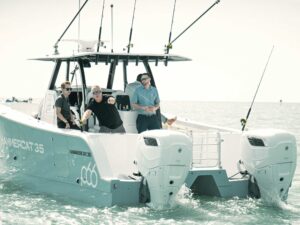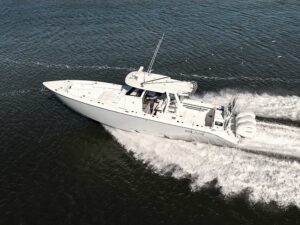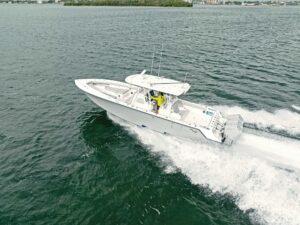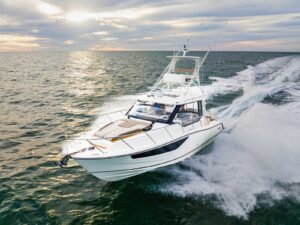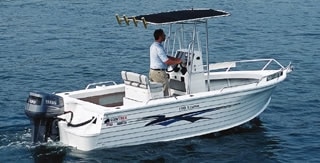
As a longtime owner of aluminum boats, I am quick to extol their virtues. “Tin boats” are lightweight, easy to trailer, rugged, low maintenance, fuel efficient and inexpensive. You can bang ’em off rocks, beach ’em where you please, launch ’em single-handed on the crudest of ramps, pull ’em with small vehicles and power ’em with small outboards. Apparently I’m not alone in my thinking. Judging by the sales of aluminum boats in Australia, there seems to be an entire continent of anglers who share my view.
Aussies love “tinnies” for all the reasons listed above, but especially for their trailerability and the fact that they can be launched almost anywhere. Now the largest boatbuilder in Australia – Quintrex – has set its sights on the U.S. market by opening a plant in South Carolina and establishing a network of dealers, most of them currently located in the Northeast. One of those dealers is Jim Pandolfe of Pandolfe’s Marine Sales in Middletown, Connecticut, who was so impressed with the boats that he decided to dump his previous line and sell only Quintrex products. “The company is great,” says Pandolfe, now the largest Quintrex dealer in the country. “They are very responsive to both the customer’s and dealer’s needs, and that’s very important in this industry. They also happen to make a solid product.”
I had a chance to find that out for myself last July, when I met Pandolfe and his wife, Wendy, at a boat ramp in Waterford, Connecticut. Behind their truck was a new 190 Legend center console powered by a Yamaha 130-hp two-stroke. Before launching, Pandolfe reviewed a few of the key features that make the 190 a cut above most other aluminum-boat designs.
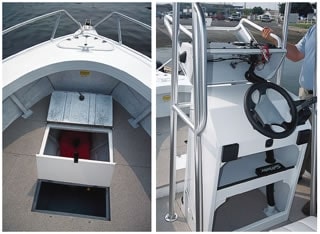
For starters, Quintrex’s stretch-forming process, which involves stretching a sheet of raw aluminum over a hull form, allows the company to create special concave hull shapes, such as the wide bow flare, that can’t be achieved through other styles of aluminum boatbuilding. Additionally, Quintrex designs all of its boats for marine use, so the hull is fully welded and made of heavy-gauge (4 mm) aluminum. (Quintrex is so confident in its boats that it offers a 20-year hull warranty.) The welded keel is 1 1/2″ thick and runs the length of the boat, and the lapstrake design provides exceptional strength. Inside, the hull is reinforced with a special cross-bracing system to prevent flexing in rough seas. The patented Millennium Hull features a sharp entry to cleave the seas and a flared bow to deflect spray. Also helping to keep occupants dry is the wide reverse chine that runs the length of the boat. Lastly, the hull tapers back to a deadrise of 17 degrees at the integral Maxi Transom, making for a stable yet seaworthy platform. In addition to providing greater stability, the Maxi Transom allows the 190 to get on plane faster and handle heavier outboards.
After launching, Pandolfe and I headed into Long Island Sound, which proved to be flat calm on this windless summer morning. The conditions didn’t really provide a fair test of the 190’s sea-handling abilities, so we had to make do with jumping boat wakes. The boat handled these well from every direction, and landed with a solid feel. Furthermore, the flared bow and reverse chines kept us bone-dry. On tight turns, the 190 tracked smoothly and gripped the water without sliding.
With a base hull weight of just over 1,400 pounds, the 190 doesn’t need much power to push it along. Although our test boat was on the heavy side, being rigged with the optional T-top and carrying a full 26 gallons of fuel in the sub-floor tank, the 130-hp Yamaha produced a top-end speed of 46 mph at 5600 rpm. Cruise was 30 mph at 4000 rpm.
At rest or when trolling, the 190 is extremely stable, thanks to its 71/2′ beam, shallow transom deadrise and wide chines. When backing down or in a following sea, the full transom provides a solid barrier that prevents water from entering the cockpit – an important safety feature. And speaking of safety, the 190 is foam-filled for positive flotation and features a self-bailing deck – not something you find on many aluminum boats. The high freeboard, which puts the gunwale tops at just above knee-height, and recessed “toe groove” along the base of the gunwale, also provide security, especially when fighting, landing or releasing a fish.
The 190’s console features lots of interior storage space and room for a single flush-mount electronics screen, as well as a tall windshield that offers full protection from wind, rain and bugs. The entire top portion of the console can be tilted forward to provide access to the wiring. On models without a T-top, this also allows for easier garage storage and bridge clearance, and improves tow-vehicle fuel economy.
| ¿ SPECIFICATIONS LOA: 18′ 9″ Beam: 7′ 5″ Weight (boat only): 1,411 lbs. Max. hp: 130 Fuel: 26 gals. Base price w/ 130-hp Yamaha outboard and trailer: $23,000 |
As for the T-top, it’s a solid, well-built affair that’s securely anchored to the deck. It features thoughtfully placed handholds and a rocket launcher along the aft edge. Just forward of the console is a 17-gallon aerated live well in the deck. A large, deep subdeck storage compartment is located forward of the live well. The bow features a lined anchor locker, plus a standard bowsprit with anchor roller. Other standard features include courtesy lights, a bilge pump, a 94-quart cooler seat with three-position backrest and storage below, and four flush-mount rod holders in the gunwales. Long, open compartments for holding loose gear run along both hullsides, although I would have liked to see these spaces outfitted with under-gunwale rod racks. Unless you order the T-top, rod storage is a bit of an issue on the 190, although some of Pandolfe’s customers have solved the problem by mounting holders along the console sides. Rod holders could also be installed along the face of the console.
The deck of the 190 is made of rot-proof Formboard that comes with a lifetime warranty, although customers can order Alloy-Core decking for greater weight savings. Pandolfe mentioned that additional in-deck compartments or fishboxes can be custom-ordered, and points out that the aluminum boatbuilding process makes it easy to customize the deck layout, as it doesn’t involve the use of fiberglass molds.
The fact that Quintrex has established a brand-new plant in South Carolina indicates the company is firmly committed to the U.S. market. Their big task now is convincing a new population of anglers that aluminum boats can handle the salt water environment. As for those of us who cut their fishing teeth in a tin boat, we’re already believers.
Quintrex Boats, Moncks Corner, SC; (843) 761-6430; www.quintrexboats.com.

